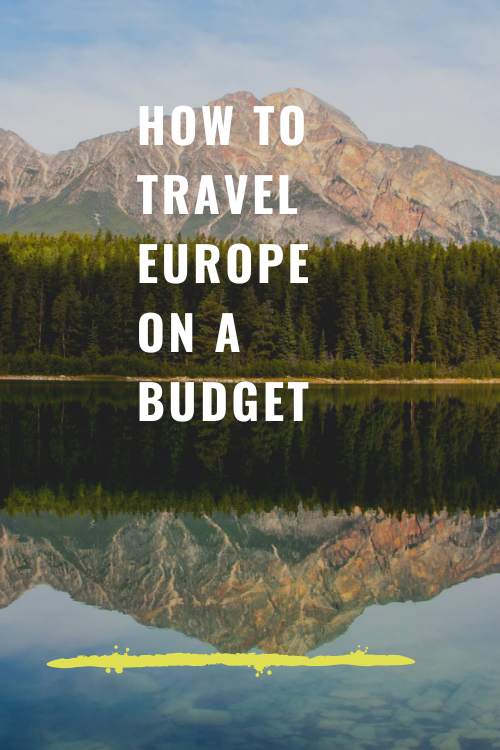How to Travel Europe on a Budget — Tips and Tricks Discover how to explore the great destinations of Europe without spending a fortune on flights, accommodation, food, and attractions.”
European Travel for Less: An American’s Guide For many, a trip to Europe from the United States is an aspiration, but it can also present a price tag that looks more intimidating. Flights, food and more — it can get expensive fast. The good news? With some savvy and a few insider tips, you can savor Europe’s signature cities, charming villages and stunning countryside without going bankrupt in the process. Well, this guide will help you travel Europe like a pro on a budget, providing tips and tricks designed for U.S. travelers who want to make the most of their adventure in the continent.
Travel During the Off-Season

Timing is everything, whether you’re a budget traveler or a slow traveler. Summer (June to August): Peak season throughout Europe, with crowds and the highest prices for flights, lodgings and attractions. But try to be there during the shoulder seasons (April-May or September-October) or better yet in winter (November-March not including holiday time).
Why it costs less: Off-season flights from the U.S. to Europe can run 20-40 percent cheaper. A round trip flight, for example, New York to Paris could be $800 in July and $450 in November.
Treat yourself: One upside of fewer tourists is shorter lines at the Louvre and Colosseum, and a more authentic experience.
Pro tip: Do your search on fare comparison sites, such as Google Flights or Skyscanner, and set price alerts to be notified when prices drop at major hubs, like London, Paris or Frankfurt. The best deals will require flexibility with your dates.
Find How to Travel Europe on a Budget flights from U.S

The price of airfare is usually the biggest cost for travelers from the U.S. to Europe. Here’s how to do it at a low cost:
Book early: Attempt to book your flights 2-6 months in advance to guarantee the If1st rates. Expedia data suggests that international flights booked out 90 days can save up to 15%.
Fly into budget hubs: Fly into the big cities — London, for example, or Amsterdam or Dublin — where existing carriers often compete for the biggest load and generally lower prices than other, smaller destinations. Then hop on a budget European carrier, such as Ryanair or EasyJet, to your destination.
Seek out budget carriers instead: Norse Atlantic Airways or PLAY, for example, will sell you an Atlantic one-way from as little as $200, but be prepared to pack light if you’re not keen on add-on fees.
Use points or miles: If you have a travel rewards credit card, redeem points for flights to Europe. For example, it takes 60,000 American Airlines miles to book a round-trip economy ticket from the U.S. to Europe.
Choose to Most Affordable Places to Visit
However, not all European countries have the same price tags. Western Europe (think France, Switzerland or Norway) has a dearer cost of living, while Eastern and Southern Europe are a fantastic value.
Top budget destinations:
Poland: The historic cities of Krakow and Warsaw provide a mix of low prices and history. A meal in a nice restaurant would cost you in $5-10 range and hostel dorms are starting from $10/night.
PORTUGAL Lisbon and Porto are budget beauties with stunning architecture and beaches. A budget hotel will run you about $20–$40.
Hungary The capital, Budapest, has thermal baths, nightlife and meals under $8.
Czech Republic: $2 beers and $15/night guesthouses reveal the fairytale charm of Prague.
Why it works: These destinations have a lower cost of living, and your U.S. dollar goes further thanks to the benefits of exchange rate.
A tip: Websites such as Numbeo can help you compare the cost of living in different cities before you finalize your itinerary.
Save on Accommodations
Accommodation can take a big chunk out of your budget, but Europe has tons of options that cater to every need and are cheap.
Hostels — Best suited for solo travelers or groups, in almost all cities will run $10-30/night for a dorm bed. Look for places that serve free breakfasts, or that have communal kitchens to cut down on meals. You can consult websites like Hostelworld, which contains user reviews that can help you choose between clean, safe options.
Airbnb or vacation rentals: Renting a room or apartment is less expensive than a hotel, and is usually worth it for longer stays. Combine that with some app that can get you a whole apartment in a city like Lisbon or Athens for $40 — 60/night.
Cheap hotels: In many European city centers you’ll find Ibis, Premier Inn, or Motel One type chains with clean, basic rooms typically in the $50-80/night range.
Hot tip: For Booking to book places with free cancellation. com if your plans change. Seek lower it ones if you can stay just outside city center — just be sure to check public transports options Џ.
[jump] Public Transport and walk
Among budget travelers, the public transport system in Europe is a best friend. Most cities offer an efficient metro system, as well as buses and trams, which are much cheaper than taxis or rideshares.
City transport A single metro ticket in a place like Madrid or Berlin will cost you $1.50-3, but a day pass (which might be $5-10) is often the better deal if you’re doing a lot of sightseeing.
Traveling between cities — The best and budgetfriendly way to get to know places is by buses, (eg FlixBus) or trains. A bus from Prague to Vienna, for example, is available from about $15 if bought in advance. How to Compare Prices: Use Omio or Trainline
Discounted rail passes: If you’re younger than 27 or a student, investigate rail passes that allow unlimited train travel across multiple countries, like Eurail or Interrail. A Eurail pass (7 days) starts at $200 for youth.
Walk as much as possible: Tons of European destinations are small, and figuring out the nearest tram stop can take up just as much time as walking to your destination (as you’ll need to walk to a stop anyhow).
Eat Like a Local

Eating is one of the great joys of travel in Europe, but dining out in touristy areas can come at a cost. Here are tips for eating well and saving money:
Street food and markets: Buy a falafel in Berlin ($4), a pastel de nata in Lisbon ($1) or a slice of pizza in Rome ($3). Markets like Borough Market in London or La Boqueria in Barcelona have great food at good prices.
Lunch specials Lots of restaurants offer discounted lunch menus. In Spain, a “menú del día” (menu of the day) combinations run about $10-15 and include starter, main, dessert, drink.
Self-catering: If your accommodation has a kitchen, stock up at a local supermarket like Lidl or Aldi. A week’s worth of simple meals might cost $20-30 in groceries.
Pro tip: Avoid restaurants close to popular attractions, which will typically charge you a premium. Well, if you go a few streets away, you get better prices and authentic vibes.
Have Free or Cheap Activities
The historic sites and the natural beauty of Europe also lend themselves to free or low-cost activities.
Museums: Many museums are free on certain days (for example, the Louvre is free the first Saturday evening of each month). Churches like Notre-Dame or St. Peter’s Basilica do not charge visitors, though they welcome donations.
Free walking tours: Most big cities offer free (tip based) walking tours. They’re terrific places to learn about history and culture while scrimping your way through.
Parks and public spaces: Stroll through London’s Hyde Park, roam the trails of Cinque Terre in Italy, chill in Budapest’s City Park — all for free.
Pro tip: Browse city tourism websites for free or cheap events and or festivals or discounted attraction passes (the Paris Pass or the Roma Pass, for example) that combine multiple sites for less.
Budget for Hidden Costs
Unexpected expenses can disrupt your budget. Here’s what to watch for:
City taxes: Many cities charge a tourist tax (e.g., $1-5/night in Venice or Barcelona) that is usually tacked onto your lodging bill.
Currency exchange: Avoid airport exchange counters, which charge exorbitant fees. To do this, find ATMs on the local currency ATMs and use cards that do not impose foreign transaction fees (such as Chase Sapphire or Capital One).
Data Roaming: You can avoid the expensive roaming rates charged by a U.S. carrier by purchasing a local SIM card (or eSIM) upon arrival for $10-20 that comes with 5-10GB of data, depending on your destination — enough for a month. Across Europe, Orange or Vodafone are solid carriers.
Pro tip: Keep a bit of cash (euros or local currency) on hand for small purchases — some vendors don’t take cards.
A 10-Day Trip on a Tight Budget
Here’s an approximate cost breakdown for a 10-day, solo trip to a European country from the U.S., if you intend to visit budget-friendly destinations like Portugal and Poland:
Airfare: $500 (round-trip, when booked months in advance and off-season)
Accommodation: $25 night x 10 = $250 (hostel or budget Airbnb
Food: $20/day x 10 = $200 (street food, grocery, restaurant check for some meal)
Transport: $100 (for buses, trains, city passes)
Activities: $100 (free attractions, no more than one or two paid museums, walking tours)
Other: $100 (SIM card, small souvenirs, cash for emergencies)
Total: ~$1,250
This is a touchstone — your expenses will vary depending on your style of travel and your destinations.
Final Tips for U.S. Travelers
Purchase travel insurance: A basic policy will cost between $20 and $50 for a short trip and will cover you for medical emergencies or trip cancellations. World Nomads: Budget travelers’ best-loved companies
Speak a few words: Most businesses want to bring in customers, so knowing a couple of words (e.g., “hello,” “thank you”) in the local language can help you get better service and sometimes better rates.
Travel light: Budget airlines impose steep fees on checked luggage. A carry-on backpack (40L or less) will usually be free to take, plus it’s easier to lug from city to city.
Be flexible: The more willing you are to alter your plans, the more likely you are to find deals on flights, accommodations and things to do.
There are definitely ways to travel Europe on a budget, with just a little planning and some creativity. Travel hacks: Finding affordable destinations, using public transportation, or experiencing local culture to create memories while avoiding headache, these are all affordable as far as we concern. Get comments and be ready to pass through of miracles of Europe!